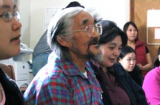JKR - Settings and scriptwriting

Setting
The Journals of Knud Rasmussen takes place in Canada's remote northeastern Arctic during the early years of the 20th Century. 700 kilometres separates the trading post in Repulse Bay, at the base of Melville Peninsula, from the one at Pond's Inlet on the northern tip of Baffin Island. Between them ranges a vast uncharted wilderness whose centre is Igloolik.
Writing the Script
The Journals of Knud Rasmussen is made by the same filmmaking team that made Atanarjuat The Fast Runner, the first feature film written, produced, directed and acted in the Inuit language. Despite being performed in a language spoken by fewer than 100,000 people on earth, The Fast Runner won the Camera d'or at the 2001 Cannes Film Festival and went on to commercial box office success in France, the U.S., Canada, the Netherlands and more than twenty other international territories. Inuktitut is an ancient oral language with no written alphabet before missionaries invented one a hundred years ago to translate the bible. Throughout four millennia Inuit passed information from generation to generation by telling stories, not writing them down. So how did we write a film script that remains true to the oral tradition, still the core of today's Inuit cultural values? Like The Fast Runner, The Journals of Knud Rasmussen began with extensive research in the Inuit oral history. Rasmussen is set in the 1920's. First, we listened to stories handed down from people who lived through that time, the parents and grandparents of people living in Igloolik today. Then we read the written journals of the period: Rasmussen's, Freuchen's and Mathiassen's memoirs from their expedition, and books by or about other visitors to the region; the traders, missionaries, whalers and first government officials sent in to establish sovereignty and control. Based on this research, we wrote an English version script for a film shot mostly in Inuktitut about how Inuit experienced this dramatic and explosive time. Why call it The Journals of Knud Rasmussen? Well, that's all we knew for the last eighty years. Until now, for the first time... From the Inuit Point of View.
- 4063 reads



